Safe Grain and Silage Handling
1995
DHHS (NIOSH) Publication Number 95-109
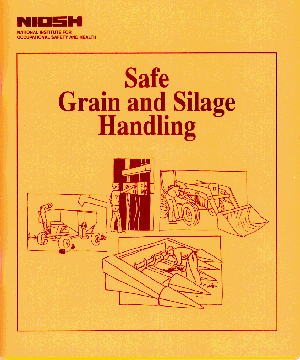
Section 1: Harvesting
"Farming looks mighty easy when your plow is a pencil, and you're a thousand miles from the cornfield."
—Dwight D. Eisenhower, 1956
34th U.S. President
Harvesting
Grain and silage harvesting have many hazards. Harvesting is often done in a short amount of time, requires the operator's attention in several areas, and uses machinery that has many moving parts, some of which are difficult to shield. The risk of injury during harvesting can be greatly reduced, however, by being aware of the hazards and following basic safety practices.
This section is the first part of a five-part handbook on grain- and silage-handling hazards. Each of the five sections of this handbook is meant to stand alone, so some hazards will be discussed in more than one section. If you have already read one of the other sections of this handbook, some of the material in this section may be a review for you.
Power Unit Safety
Tractor rollovers are the largest single cause of agricultural machinery-related deaths. Why are rollovers so serious? Rollovers can occur so quickly that you cannot react in time to jump off the tractor or get out of the way. Rearward rollovers can occur in 1.5 seconds and rollovers to the side can occur in 0.75 seconds. The point at which the tractor will continue to roll and not fall back on its wheels (Figure 1-1), can be reached in 0.75 seconds for rear rollovers and 0.5 seconds for side rollovers. A person needs 0.3 to 1 second or more to recognize and respond to an unexpected event, depending upon the person, what that person is doing, and the distance the person has to move to respond. In many rollover circumstances, then, you simply could not react quickly enough to avoid injury after you realized that the machine had started to roll. The ways to prevent injury from a rollover are to prevent the roll from occurring and to protect yourself from being crushed if a roll should occur.
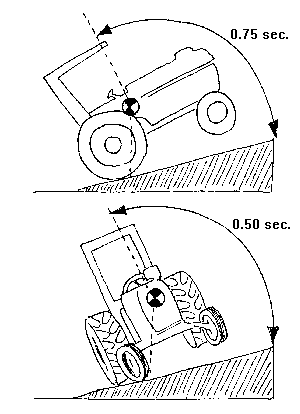
Figure 1-1. A tractor can reach the point at which it will continue to roll and not fall back on its wheels in 0.75 seconds for rear overturns and in 0.5 seconds for side overturns. In many cases, you cannot react quickly enough to stop the overturn or jump to safety.
Roll-Over Protective Structures (ROPS)
Safe practices can reduce the chance of a rollover but not completely eliminate it. Roll-over protective structures (ROPS) can greatly reduce your chances of being killed if an overturn does occur. ROPS are designed to limit most rollovers to 90º and prevent operator deaths for rolls greater than 90º (Figure 1-2). These designs assume that the operator stays in the seat. To make sure you stay in the seat, you should always wear a seatbelt on machinery equipped with a ROPS. You shouldn't use a seatbelt on equipment without a ROPS, since staying in the seat on such equipment could increase your chances of injury.
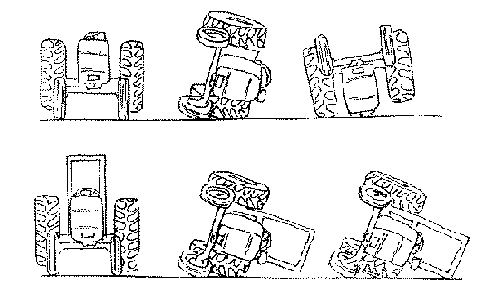
Figure 1-2. ROPS are designed to limit overturns to 90º, and prevent operator deaths for rolls greater than 90º.
Although it is a good safety practice to use ROPS wherever possible, many farmers have an older tractor that does not have a ROPS. If you have a tractor without a ROPS, you can decrease your chance of being injured by using that tractor for jobs where a rollover is less likely to occur. Examples of such jobs would be stationary power take-off (PTO) use, pulling light loads, and working at lower speeds on flat, firm terrain.
You can greatly increase your safety if you equip all of your tractors with a ROPS. Be sure that the ROPS has passed the standards of one of the following organizations: the American Society of Agricultural Engineers (ASAE), the Society of Automotive Engineers (SAE), or the Occupational Safety and Health Administration (OSHA). Look for a sticker or tag stating the ROPS has been approved by one of these organizations.
Tractor Wheel Spacing
Tractor wheels should be adjusted to the widest spacing that can be used for each job. The wider the tread width, the less the chance of a sideways overturn.
Extra Riders
The only person who should be riding a tractor or self-propelled harvesting unit is the operator, unless the equipment manufacturer has provided a second seat. Extra riders can be thrown off or fall from the machine and be run over, or they can interfere with proper operation of the machine (Figure 1-3).
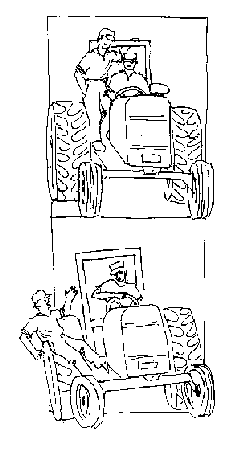
Figure 1-3. Extra riders DO fall from equipment, often in front of the tires or a trailed implement. The driver can rarely react in time to avoid crushing this person.
Matching Power and Load
The tractor used to pull a harvester and wagon should be large enough to control the load. A tractor that is too small may not have sufficient braking power, weight, or traction to slow heavy loads or control them when going down or across a hill. Loss of traction can lead to an overturn.
Harvester and wagon combinations can cause rollovers if sharp turns are made when going downhill or at highway speeds, especially if the wagon is loaded. It is easy to forget that when a sharp turn is made, the force from the trailing equipment will try to jackknife and roll the tractor.
The individual brakes on tractors and self-propelled harvesters are good for providing control at slow speeds in soft or slippery conditions. These brakes should always be locked together, however, when traveling at highway speeds. Applying an individual brake at higher speeds can jackknife the equipment and lead to an overturn.
Another cause of upsets is tire blowout. Make sure that your tractor and wagon tires don't have deep cuts or cracks that could lead to a blowout and loss of control.
Stumps, rocks, ditches, or holes in fields are often forgotten as rollover hazards. It is easy to pay attention to the harvesting behind you and forget to watch for one of these dangers in front of you. One way to remember these hazards is to mark the field with tall painted stakes or flags when the crop is small and the hazards can be easily seen. Banks of ditches or streams are also common overturn sites. Banks that were stable at planting may have eroded or may not be able to support the weight of harvesting equipment. Always leave plenty of room when turning or driving near a bank edge. The distance from the tires to the bank edge should equal the ditch depth (Figure 1-4).
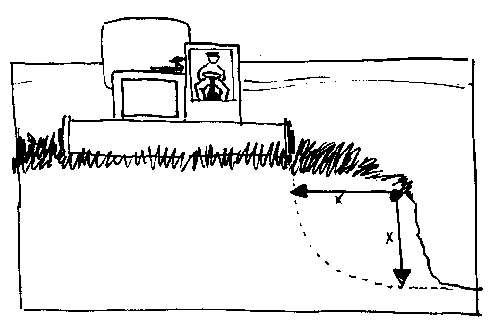
Figure 1-4. Always leave plenty of room when turning or driving near a bank edge. Try to keep the distance from the tires to the bank edge equal to the ditch depth.
Power Take-Offs and Drivelines
Although much has been published about the safe practices that should be followed when working around PTOs and drivelines, amputations and other severe injuries still occur. The way to prevent injury from PTO shafts and drivelines is to avoid contact and prevent entanglement if contact should occur. Although it is common sense to avoid contact with a driveline, injuries still occur when people step across or reach over or under a PTO shaft or driveline (Figure 1-5).
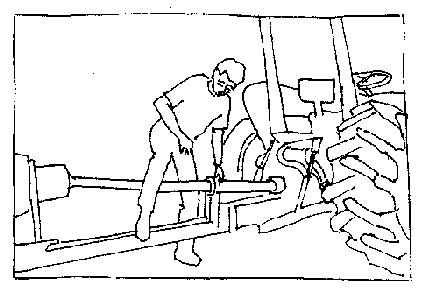
Figure 1-5. Never reach or step across an operating driveline, even if it is shielded.
Shielding
PTO shafts and implement input drivelines should be shielded. The irregular shapes of the shafts and flexible joints grab loose clothing and hair very easily. Shields that were designed to rotate separately from the shaft that is inside should do so easily. This condition should only be checked, of course, with the shaft stopped. Rotating shields should be smooth and free from cracks or sharp edges that could entangle clothing, hair, or body parts.
Clothing
The clothing worn while working around PTO shafts, and other equipment, can also help to prevent entanglement. Work clothing should be well-fitting and zippered or buttoned, not open. Frayed clothes, jackets and sweatshirts with drawstrings, and boots or shoes with long shoelaces should be avoided. A shoelace or loose string, thread, flap of cloth, or the corner of a jacket can become entangled very easily.
Hitching Height and Distance
It is also important to use the correct hitching height and distance for a PTO-driven implement. An improper hitching position can cause the drive shaft to fail or separate. When a PTO shaft fails or separates, the loose or broken ends can whip around violently and may cause severe injuries. Check the owner's manual for the proper hitching position (Figure 1-6). When using stationary PTO-driven implements, leave the implement hitched to the tractor so that the hitching distance doesn't change.

Figure 1-6. Check the owner's manual for the correct hitching height and distance when using PTO-powered equipment. An incorrect distance can cause the drive shaft to separate or fail.
HARVESTING UNIT SAFETY
Combines were the third largest cause of agricultural machine-related fatalities for the period 1980 to 1985. Combines are also involved in about twice as many injuries per 1,000 machines as tractors, yet are used fewer hours per year.
Harvester Servicing
About 50 percent of the reportable injuries from combines occur while cleaning, repairing, or adjusting the machine. Before performing any service, lower the header to the ground, place the machine in park or neutral, set the brake, stop the engine, and take the key with you. The owner's manual will specify those few operations that must be performed with the engine and machinery running or the header raised.
Never try to clear a clogged harvester with the machine running. If the clogged material clears, you can be pulled into the machine before you can react to let go or pull back (Figure 1-7). For example, corn is pulled through combine snapping rolls at more than 12 feet per second. If you are 3 feet from the rolls, your hand will be caught in 0.25 seconds. A person needs between 0.3 and 1 second or more to recognize and respond to an unexpected event. You cannot physically react in time; you will be caught! Stop the engine before clearing a clog to avoid this hazard.
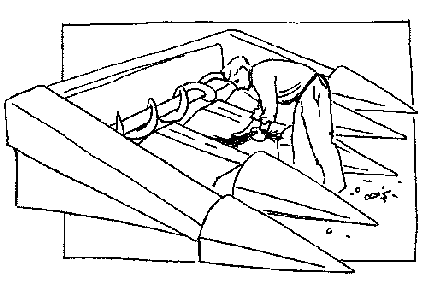
Figure 1-7. Never try to clear a clogged harvester with the machine running. If the clog clears unexpectedly, you can be pulled into the machinery before you can let go.
Make sure harvester headers can't come down before getting under them (Figure 1-8). Use the manufacturer's hydraulic cylinder safety stops, if they were provided. If you have to use jacks, place them on firm, level surfaces, but use solid blocks to hold the machine when it is in position. Don't rely on jacks or other hydraulics for support; these can slip or develop leaks and you may be crushed.
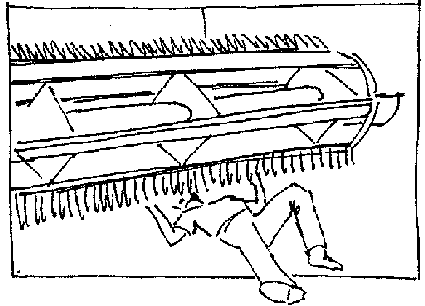
Figure 1-8. Make sure that harvester headers can't come down before working under them. Use the manufacturer's hydraulic cylinder safety stops, if they were provided. If you cannot use safety stops, hold the header in place with solid blocks. Don't rely on jacks or hydraulics for support; if these slip or develop leaks you can be crushed.
Check for the rotation of forage harvester knives before opening access doors. The knives can rotate for a long time after the engine power is stopped. Even though the knives may rotate for a long time, let them stop on their own. Trying to stop the knives with a piece of wood or metal can damage the machine, draw you into the knives, or injure you with flying pieces.
Always follow the manufacturer's recommendations when sharpening forage harvester knives, or when replacing knives, forage blower blades, or combine cylinder bars. Be sure to torque the knife, blade, or bar attachment bolts to specifications. A loose bolt, nut, or part can become a lethal projectile.
Road Safety
Some harvester injuries are caused by collisions with other vehicles. Before traveling on the road, adjust hitches, fold unloading augers, or remove headers to make the machine as narrow as possible. Try to alert motorists as far in advance as possible by keeping bright, reflective Slow Moving Vehicle (SMV) symbols on all harvesters, tractors, and wagons. Use warning lights when possible. Signal all turns with lights or hand motions.
To allow traffic to pass, wait for a safe place, then pull off onto the shoulder and stop. Don't drive on the shoulder. The shoulder may be rough or have other handling hazards that could lead to an overturn. If your vehicle does start to tip into the shoulder, steering down into the ditch may prevent a complete overturn (Figure 1-9).

Figure 1-9. Pull onto the shoulder and stop to let traffic pass. Don't drive on the shoulder; it may contain holes or other hazards that can cause overturns. If your equipment does start to tip into the shoulder, steering down into the ditch may prevent a complete overturn.
When going downhill, leave the transmission in a mid-range or low gear. Don't take the chance of losing control by shifting to neutral or leaving the machine in a high gear.
Consider having an escort vehicle follow to help alert motorists (Figure 1-10). This is especially important if left turns have to be made. Collisions can occur when machinery starting a left turn is hit by a car passing from behind.
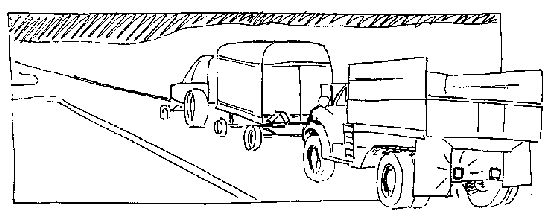
Figure 1-10. Since most wagons don't have turn signals, consider using an escort vehicle to help alert other drivers. Collisions occur when machinery starting a left turn is hit by a car passing from behind.
Harvester Stability
Harvester stability is very dependent upon the header and grain tank. Heavy headers can tip the combine to the front. Keep the header as close to the ground as possible when traveling on or off the road.
The weight of the crop in the grain storage tank raises the harvester's center of gravity (Figure 1-11). Raising the center of gravity makes the machine easier to tip. Avoid traveling at highway speeds with a full grain tank and reduce your travel speed for all turns, on or off the road. Don't extend the tank height beyond that recommended by the manufacturer. Extending the tank too much can make the harvester top-heavy and prone to an overturn and could possibly damage the combine's frame.
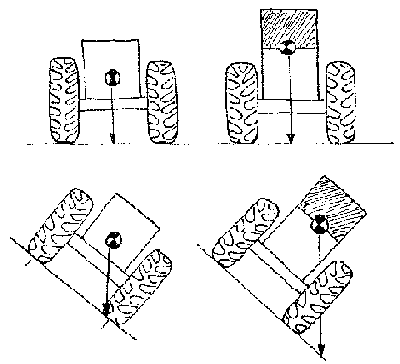
Figure 1-11. The weight of the crop in the grain-storage tank raises the harvester's center of gravity, the avarage position of the harvester's weight. Extending the tank height above that recommended by the manufacturer can make the harvester top-heavy and prone to an overturn. If the center of gravity is outside the wheels, the vehicle will overturn. The stability of moving vehicles is more difficult to predict, but keeping the center of gravity low will reduce the chance of an upset.
Make wide turns on slopes, especially when turning uphill. Tight turns can result in slipping, loss of control, and a rollover.
Falls
In some parts of the country, falls cause about 50 percent of the injuries due to machinery. A fall from a combine can be as much as 14 feet, and may result in a serious injury. Performing preventive maintenance in the off-season when you aren't in a hurry will help you reduce your chance of falling. If you must service machinery in the field, take time to clean the crop dust and debris from the steps and platforms you will stand on while working, and wear shoes with a solid, slip-resistant tread. Good traction will reduce your chance of slipping and falling.
Fires
Harvesters can be fire hazards. Chaff and other bits of plant material can be ignited by engine components or from the heat of failing bearings or slipping belts. Fire hazards can be reduced by keeping belts tight, frequently removing dust and chaff buildup, and checking bearings regularly. It is also a good practice to have a multi-purpose (A-B-C) fire extinguisher (5-pound minimum, 10-pound is better) on all tractors or self-propelled machines. Also consider carrying a 2 1/2- or 5-gallon pressurized or pump, type A fire extinguisher on combines. These extinguishers are better than type A-B-C extinguishers on type A fires (chaff and plant material) in windy conditions.
Fires can also be caused by the exhaust systems of cars or trucks, especially gasoline-fueled ones. Gasoline-fueled vehicles may have catalytic converters that will glow red hot under normal use. Straw or stubble that comes in contact with a hot catalytic converter can easily catch fire. The risk of field fires can be reduced by keeping trucks and cars out of the field, or by cutting the crop very short in the loading areas and haul roads.
- Page last reviewed: June 6, 2014
- Page last updated: June 6, 2014
- Content source:


 ShareCompartir
ShareCompartir